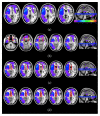Emotion Recognition in Low-Spatial Frequencies Is Partly Preserved following Traumatic Brain Injury
- PMID: 30809551
- PMCID: PMC6369464
- DOI: 10.1155/2019/9562935
Emotion Recognition in Low-Spatial Frequencies Is Partly Preserved following Traumatic Brain Injury
Abstract
After a Traumatic Brain Injury (TBI), emotion recognition is typically impaired. This is commonly attributed to widespread multifocal damage in cortical areas involved in emotion processing as well as to Diffuse Axonal Injury (DAI). However, current models suggest that emotional recognition is subserved by a distributed network cantered on the amygdala, which involves both cortical and subcortical structures. While the cortical system is preferentially tuned to process high spatial frequencies, the subcortical networks are more sensitive to low-spatial frequencies. The aim of this study was to evaluate whether emotion perception from low-spatial frequencies underpinning the subcortical system is relatively preserved in TBI patients. We tested a group of 14 subjects with severe TBI and 20 matched healthy controls. Each participant was asked to recognize the emotion expressed by each stimulus that consisted of happy and fearful faces, filtered for their low and high spatial frequencies components. Results in TBI patients' performances showed that low-spatial frequency expressions were recognized with higher accuracy and faster reaction times when compared to high spatial frequency stimuli. On the contrary, healthy controls did not show any effect in the two conditions, neither for response accuracy nor for reaction times. The outcomes of this study indicate that emotion perception from low-spatial frequencies is relatively preserved in TBI, thereby suggesting spare of functioning in the subcortical system in mediating emotion recognition.
Figures







Similar articles
-
A Rapid Subcortical Amygdala Route for Faces Irrespective of Spatial Frequency and Emotion.J Neurosci. 2017 Apr 5;37(14):3864-3874. doi: 10.1523/JNEUROSCI.3525-16.2017. Epub 2017 Mar 10. J Neurosci. 2017. PMID: 28283563 Free PMC article.
-
The influence of attention and arousal on emotion perception in adults with severe traumatic brain injury.Int J Psychophysiol. 2011 Oct;82(1):124-31. doi: 10.1016/j.ijpsycho.2011.01.014. Epub 2011 Feb 17. Int J Psychophysiol. 2011. PMID: 21315778
-
Facial emotion recognition deficits following moderate-severe Traumatic Brain Injury (TBI): re-examining the valence effect and the role of emotion intensity.J Int Neuropsychol Soc. 2014 Nov;20(10):994-1003. doi: 10.1017/S1355617714000940. Epub 2014 Nov 14. J Int Neuropsychol Soc. 2014. PMID: 25396693
-
Distributed and interactive brain mechanisms during emotion face perception: evidence from functional neuroimaging.Neuropsychologia. 2007 Jan 7;45(1):174-94. doi: 10.1016/j.neuropsychologia.2006.06.003. Epub 2006 Jul 18. Neuropsychologia. 2007. PMID: 16854439 Review.
-
Emotion perception deficits following traumatic brain injury: a review of the evidence and rationale for intervention.J Int Neuropsychol Soc. 2008 Jul;14(4):511-25. doi: 10.1017/S1355617708080703. J Int Neuropsychol Soc. 2008. PMID: 18577280 Review.
Cited by
-
Visual Perception in Autism Spectrum Disorder: A Review of Neuroimaging Studies.Soa Chongsonyon Chongsin Uihak. 2020 Jul 1;31(3):105-120. doi: 10.5765/jkacap.200018. Soa Chongsonyon Chongsin Uihak. 2020. PMID: 32665755 Free PMC article.
-
The Neurobiological Links between Stress and Traumatic Brain Injury: A Review of Research to Date.Int J Mol Sci. 2022 Aug 23;23(17):9519. doi: 10.3390/ijms23179519. Int J Mol Sci. 2022. PMID: 36076917 Free PMC article. Review.

